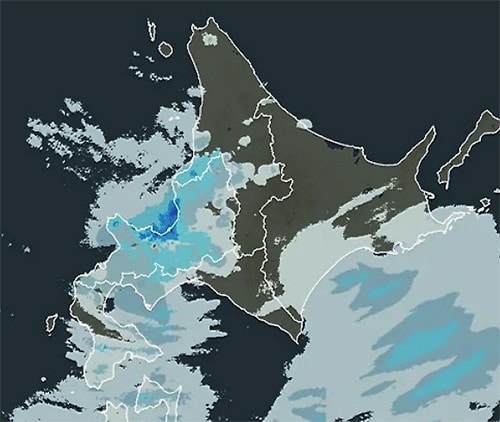



本日早朝目覚めたら、ごらんのような景色がわが家前に出現。
ことしの冬は,夏が非常にながく暑かったのでさてどうなるか、と思っていましたが季節の進み方はそれなりに順調で、ようやくのまとまった降りようであります。12月に入ってからはそこそこに除雪はしていましたが、ついに本格的雪かき出動が必要といったところ。
写真は12/27 午前4時前に撮影したものですが、道路除雪の様子からは降雪はたぶん昨日の夜になってからのようで市の除雪車が入ってその後はあんまり降っていない様子であります。その下のように天気状況図を確認してみると、わが家周辺には昨晩20時以降、活発な雪雲が出張ってきていることが確認できた。
そこそこの半「ドカ雪」っていうところ。急に降ってきてダラダラしないで降り終わったみたいな降雪。予報でもきょう午前中まで降雪の可能性があり、その後は晴れマークが出ています。
まぁ冬将軍様、軽いごあいさつと言ったところでしょうか。
最近はすっかり温暖地・広島県福山市の草戸千軒遺跡の探訪シリーズに耽溺。あたらしく興味を持っていただいたみなさんも多いようで書き込みへの好意的な反応も見られましたが、ここはいったん休憩。
家系の縁の強い地域とは言え、わたし自身は生まれながらの生粋の北海道人。雪が降ってくれば、おのずと体内からスイッチが入る部分がある。戸建て住宅の住まい手として50年以上は暮らし続けてきているので、人によって違いはあるけれど、雪国人間としては除雪作業への「運命感」は共通していると思う。
ということで、たぶん1時間ほどは除雪作業に没頭すると思われるので、毎朝のブログ書き込み作業は、ちょっと時間的制約から本日は「軽め」とさせていただきます。さてやるか、であります、おーっ!
追伸:約1.5時間で3箇所(自宅・事務所前、駐車場2箇所)除雪を完了。ふ〜としていたら、読者の方からすばらしい「解説・説明」投稿。わかりやすく科学的なので、了解いただき加筆転載します。
〜札幌市の除雪は基本的に降り終わるのを見極めてから出動する。そのために小樽の毛無山にある気象レーダーが活躍する。北海道にはこのほか函館の横津岳と釧路町昆布森にも気象レーダーがあり、降水のリアルタイムの把握や数時間程度の将来推定を気象庁のHPからいつでも閲覧できる。
これらは15年くらい前にドップラーレーダーに換装され、雨雲の位置の他に移動速度もわかるようになった。このため、気象庁の降水予想は高精度となり、数kmのオーダーの分単位の細かい予想が可能になっている。リモートセンシング技術と解析技術は、10年単位で革新され、われわれは知らず知らずのうちにその恩恵にあずかっている。 by Shigeru Narabeさん。〜
English version⬇
Sapporo, the last week of the year, is the snow shoveling in full swing 🎵.
The winter general of semi-"Boomerang snow" has arrived. I have been living in a detached house in snow country for more than 50 years. When it snows, it turns on my DNA. The roar of the snow removal warriors! ・・・
When I woke up early this morning, the view in front of my house was as you can see.
I had been plowing since the beginning of December, but finally I had to start shoveling snow in earnest.
The photo was taken before 4:00 a.m. on 12/27, and from the look of the street plows, it seems that the snow probably started falling last night, and not much has fallen since the city's snowplows arrived. Checking the weather map below, I could see that there was an active snow cloud around our house after 8 pm last night.
It was a semi "heavy" snowfall. It was the kind of snowfall that came suddenly and ended up falling without lingering. The forecast also shows a chance of snowfall until mid-morning today, followed by clear skies.
Well, General Winter, I guess you could say I have a light greeting for you.
Recently, I have been indulging in a series of visits to the Kusado-Senken site in Fukuyama City, Hiroshima Prefecture, a warm climate area. Many of you seem to have taken a new interest in the site and have responded favorably to my posts, but I am going to take a break for now.
Although I have strong family ties to this area, I myself am a native Hokkaidoan. When the snow falls, there is a part of me that naturally turns on inside of me. I have been living in a detached house for more than 50 years, and although there are differences among people, I think we all share the same sense of "destiny" for snow removal work as people from snow country.
So, since I will probably spend about an hour or so immersed in the snow removal work, I'm going to lighten up on my blog writing today due to time constraints. Let's do it, shall we?
P.S.: I finished removing snow from 3 areas (in front of my house and office, and 2 parking lots) in about 1.5 hours. While I was relaxing, a reader posted a wonderful "explanation/explanation. It is easy to understand and scientific, so I am reprinting it here with your permission.
〜The city of Sapporo basically waits until the snowfall is over before going out to remove it. For this purpose, a weather radar located at Mt. In addition to these radars in Hokkaido, there are also weather radars at Yokotsudake in Hakodate and Kombumori in Kushiro Town, which allow real-time monitoring of precipitation and future estimates of a few hours to be viewed at any time from the JMA website.
These radars were converted to Doppler radar about 15 years ago, and now provide information on the location of rain clouds as well as their speed of movement. As a result, the JMA's precipitation forecasts have become highly accurate, and minute-by-minute detailed forecasts on the order of several kilometers are now possible. Remote sensing and analysis technology has been revolutionized over the past decade, and we are unknowingly reaping the benefits of these innovations. by Shigeru Narabe. ~



















